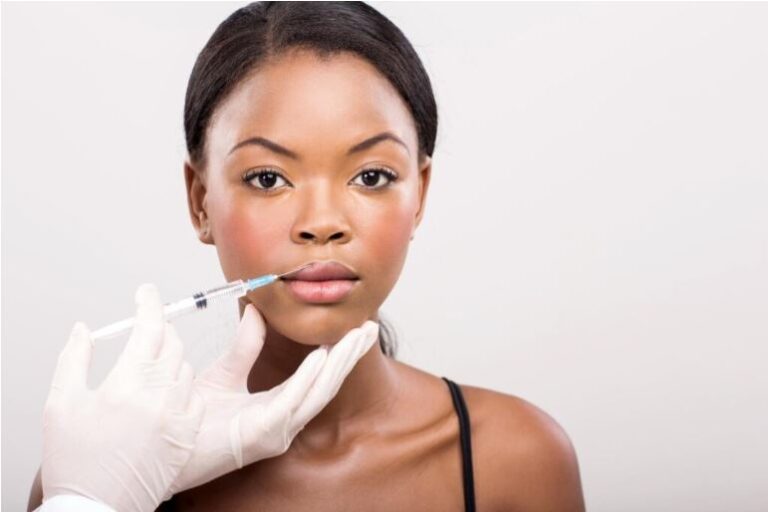Although brown skin ages differently from white skin, in its own way, it does begin to show the passage of time. Wrinkling is not as noticeable in brown skin, but creasing and sagging of the skin in the nasolabial folds and in the marionette’s lines become noticeable. Additionally, there is a loss of volume of the face with the hollowness of the area around the eyes and upper cheeks, as well as the formation of frown lines in the forehead. These changes occur because the collagen and elastic tissue in the dermal portion of your skin, which keeps it taut and youthful, begins to break down. A new and innovative way to compensate for the breakdown and restore youth and fullness is to inject filler substances into the skin. These fillers, which include hyaluronic acid, fat, collagen, and other materials, are used to plump up wrinkled, creased, and sunken areas of the face, and to add fullness to the cheeks and lip areas.
Filler materials are very popular for men and women with brown skin because they address the unique way in which skin of color ages. That is, in brown skin, there is a loss of volume of the area underlying the skin which results increases, sagging, and hollowness. But filler substances are not for everyone and should be avoided if there is a history of keloid formation. Fillers should also be avoided if you have any type of facial skin infection or inflammation. Many doctors will prescribe an oral antiviral medication for individuals with a history of cold sores or fever blisters to prevent a possible recurrence associated with injection of the filler substance.
There are several variables that determine how long the filler material lasts. In addition to the composition of the material, researchers believe that age, genetic background, skin quality, and lifestyle as well as the injected body site may all play a role in the lasting power of the filler. Injections into areas of the face that move frequently during smiling, chewing, talking, etc., do not last as long as other areas.
As with all procedures, fillers should be injected by a dermatologist experienced with brown skin. Prior to your injection, any medications that can promote bruising or bleeding should be avoided. Special care is not required after your injection. Bruising, swelling, or redness at the injection sites sometimes follows injections. Temporary puffiness and tenderness around the treated areas can also be expected. These side effects are usually minimal, and make-up may be used afterward to cover them. In some cases, bluish bruising may be seen, which disappears within 5-7 days.
The following chart is an overview of the characteristics of the most commonly used filler substances in the United States today.
| Brand Name | Company | Type | Specific Uses | Pretesting Required? | Duration of Results |
| Restylane | Medicis | Hylaronic Acid Gel (non-animal source) | Dermal filler used for filling creases, wrinkles, scars and lip enhancement | No | 6 months on average with re-treatment every 6-9 months |
| Restylane Fine lines* | Medicis | Hylaronic Acid Gel (non-animal source) | Dermal filler with a smaller gel particle size (compared to Restylane) used to correct thin superficial lines. | No | Same as above |
| Restylane SubQ* | Medicis | Hylaronic Acid Gel (non-animal source) | Subcutaneous filler with the largest gel particle size (compared to Restylane) used to replace fat loss in the face and create, restore and define facial contour. | No | Same as above |
| Perlane* | Medicis | Hylaronic Acid Gel (non-animal source) | Deeper dermal filler with a larger gel particle size (compared to Resylane) used to fill deeper creases and more prominent facial lines. | No | Same as above |
| Hylaform Hylaform Plus Captique | Inamed Aesthetics | Hylaronic Acid Gel from rooster combs andCaptique, nonanimal source | Dermal filler used for filling creases, wrinkles, scars and lip enhancement | Although from an avian source, no prior testing required | Average treatment lasts 3 months, requiring touch-ups every 3-4 months |
| Juvederm 18 | Inamed Aesthetics | Hylaronic Acid Gel | Filler used to treat superficial lines (crows feet) | No | Lasts 6-9 months |
| Juvederm 24 | Inamed Aesthetics | Hylaronic Acid Gel | Dermal filler used for forehead wrinkles, frown lines, and mild nasolabial folds | No | Lasts 6-9 months |
| Juvederm 24 HV | Inamed Aesthetics | Hylaronic Acid Gel | Dermal filler with higher viscosity than Juvederm 24, used for deeper wrinkles and creases. | No | Lasts 9 months |
| Juvederm 30 | Inamed Aesthetics | Hylaronic Acid Gel | Dermal filler used for deeper creases, more prominent facial lines and to add volume to the lips and contours of the face. | No | Lasts 6-9 months |
*Not FDA approved
| Brand Name | Company | Type | Specific Uses | Pre-testing | Results Last |
| Cosmoderm | INAMED Corporation | Human collagen | Dermal filler used to treat fine lines (around the nose, mouth and frown area) and acne scars | No | Lasts 3 months |
| Cosmoplast | INAMED Corporation | Human collagen | Dermal filler used to treat deeper lines and furrows | No | Lasts 3 months |
| Zyderm | INAMED Corporation | Purified bovine (cow) collagenwith 0.3% lidocaine | Zyderm 1 used to treat fine lines, wrinkles and shallow scarsZyderm 2 used to treat moderate lines, wrinkles and scars. | Yes | Lasts 3 months |
| Zyplast | INAMED Corporation | Purified bovine (cow) collagenwith 0.3% lidocaine | Used to treat deeper lines and wrinkles and scars | Yes | Lasts 3 months |
| +Sculptra | Dermik Aesthetic | Poly-lactic acid | Dermal filler that stimulates the production of your own collagen. | No | Lasts 2 years |
| *Artecoll | Rofil Medical | Contains Polymethylmethacrylate microspheres (PMMA) enclosed in a solution of 3.5% collagen and 0.3% lidocaine | Used to treat deeper wrinkles as the collagen is absorbed leaving polymethylmethacrylate (PMMA) to stimulate new collagen | Yes | 1 year but may be permanent |
*Not FDA Approved in the United States
+Not FDA Approved in the United States for cosmetic purposes
Hyaluronic Acid
Your skin is composed of the upper epidermal layer and the deeper dermal layer, which is made up of collagen and elastin connective tissue. The area in-between the collagen and elastin includes the clear jelly-like substance hyaluronic acid. Hyaluronic acid, which is found in all vertebrates, is a natural sugar that attracts and binds with water to keep your skin firm, moist and elastic. Hyaluronic acid fillers provide structural support for the collagen that is diminishing in your skin. Since most of the hyaluronins are not derived from animal extracts, there is minimal risk of developing an allergic reaction. Therefore, unlike collagen, which requires allergy testing, this treatment can be performed at the same time as your consultation.
Hyaluronic fillers are injected into the dermal layer of your skin with a small needle. A series of small injections are made along the areas being treated and the area is then vigorously massaged to evenly distribute the substance and prevent lumps or nodules. Some women find the injection to be uncomfortable, but a topical anesthetic, applied 30 minutes before the injection, will minimize discomfort. The injection procedure itself takes about 15 minutes and the results can be seen immediately. With fillers substances, there is no real downtime, and you can return to your work and normal activities immediately afterwards.
Since hylaronic acids bond with water and this causes an expansion that contributes to the final volume that is achieved, your doctor will avoid overfilling the treated area with hyaluronic acid. Often it is helpful to come in for a touch up session in about one or two weeks after your first treatment. Overfilling can lead to bumps and irregularities, which, although rare, can represent a small, temporary cosmetic problem. Hyaluronic fillers have higher biocompatibility and last longer than collagen implants, which means fewer re-injections would be needed to maintain the effects of your treatment.
Like other fillers, treatment with hyaluronic acid is not permanent and it will over time degrade and be absorbed by the body. Although everyone’s body resorbs fillers at different rates, in general, visible results last about 6 months. Most women return to their doctors for touch ups as they begin to notice the effects of the injections fading, and re-injections are usually performed every 6-8 months.
Restylane
There are several different types of hyaluonic acid products although the most commonly used is Restylane, which was approved by the FDA in December 2003 for the treatment of mid-to-deep dermal implantation for the correction of moderate to severe facial wrinkles and folds, such as the nasolabial folds. Restylane is a non-animal stabilized hyaluronic acid. It is produced by genetically engineered strains of the bacteria, Streptococcus species. Since naturally occurring hyaluronic acid is rapidly cleared by the body, the hyaluronic acid molecule is stabilized by cross-linking. With Restylane, minimal cross-linking is required. The degradation of Restylane is isovolumetric which means that its capacity to bind water increases as its concentration in the dermis decreases so that the effects continues until almost all of the material is absorbed. Restylane is supplied in 1.0 mL and 0.4mL syringes. Typically 1.0 mL-1.5 mL is required to correct one nasolabial fold. A 0.4 mL syringe is typically used for a touch up session.
Fat
Your own fat cells may be used as a filler substance. Fat implants, also called autologous fat transplantation, are taken from a donor area in your body—usually your abdomen, and re-injected in the area where you want it.
This popular filler substance eliminates the possibility of allergic reactions since this filler comes from your own body. The actual procedure takes less than an hour and there is little downtime afterwards. You can usually resume activities immediately thereafter.
A local anesthetic is used to numb the donor and recipient sites. Fluids are usually injected at the donor site in order to facilitate the fat collection, which is obtained with a large-bore needle or a cannula (the same instrument used in liposuction) attached to a suction device. After being removed, the fat is processed to remove any blood or fluids and then injected in multiple strands into the treatment area with another needle.
With fat injections, your doctor will most likely overfill the area as some of the fat will be resorbed immediately following the treatment. Overfilled areas on the cheeks and face will result in a puffy look that will subside within a few days. Like other forms of fillers, fat injection is not permanent. The majority of patients discover that about half the injection fullness has disappeared within 3-6 months. Results last longer in areas that are relatively motionless, like your cheeks.
Fat injections are generally well tolerated although there is a small risk of infection. Swelling, bruising, or redness in both the donor and recipient sites may occur, but this usually lasts a brief period of time. Your physician will be able to advise you if fat is an appropriate filler substance for you.
Collagen
Collagen has been available as a filler substance since approved by the FDA in 1981. Collagen is a naturally occurring substance found throughout the bodies of not only humans but also most animals. Skin, bones, tendons, and muscles are composed of various types of collagen. In the skin, collagen provides a scaffold to support and shape it.
The original collagen fillers came from cows. Bovine collagen is composed of highly purified cow dermal tissue, which is obtained from the hides of steers. The purification process creates a product similar to human collagen. Despite the purification process, allergy to bovine collagen may occur. Two skin tests are administered one month apart to determine if there is an allergy to collagen. Redness, swelling, or itching are possible signs of a positive allergy test. Most people have no problems, although approximately 3 in every 100 people cannot be treated.
Collagen is injected using a fine needle inserted at several points along the edge of the treatment area. The injections are usually well tolerated because the anesthetic agent, lidocaine, is combined with collagen. However, if you are especially sensitive to pain, your doctor may use a topical cream anesthetic to numb the area. Since collagen may be absorbed by your body within a few days of injection, your doctor will slightly overfill the area.
There are several side effects that could possibly occur following treatment. These include minor discomfort, stinging or throbbing in the treated area. Bruising, swelling and redness that appears in the injected site usually disappears within 12-24 hours. Most people experience little downtime and usually return to work the next day.
The duration of the collagen injection is variable. Longevity is related to the part of the body you decide to have treated with this filler. Effects are likely to disappear faster in areas that are more affected by muscle movement. Most patients see considerable improvement in 1-3 treatment sessions depending on the size, shape, and texture of the area being treated. Most people have collagen re-injected after 3 months or so, but your doctor will be able to help you determine how long you can go between treatments to best maintain your results.
Bottom Line
The use of dermal fillers is a very popular method to hold at bay some of the signs of aging that occurs in men and women with brown skin. Fillers are, in general, a fast and relatively painless alternative to more drastic anti-aging procedures. Since they do involve the injection of a foreign substance into the body, the decision must be well thought out and discussed at length with your dermatologist.
Learn more about derma fillers and setting up an appointment.


